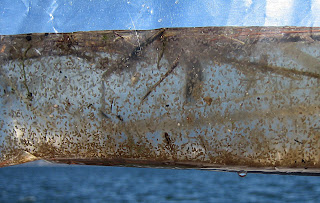While at the Connecticut Conference on Natural Resources last week, Dennis Varza and I bumped into
Jack Barclay after one of the classroom sessions.
Jack mentioned that he would like to collect plankton samples off the coastline from Norwalk to Stratford.
It took no arm twisting at all to have me fire up the outboard and start this St. Patricks Day journey.
Instead of being at a parade with marching bands, pipes and drums corps and others, we ran into a different parade, this one was of gulls, thousands of them along with hundreds of other birds, such as brant, black duck, and scaup, all feeding on the microscopic life we know as plankton.
They all had one thing in common, that was to feast not on corned beef, but the bountiful masses of the various plankton that were afloat to the waters surface.
It was easy to find the plankton, just find the birds
Jack provided all the equipment needed, most importantly this plankton seine.
We would make a slow troll with it at about two knots and for several hundred yards before hauling it back on board.
This bottle at the end of the net is the capture tank that holds everything we gathered on the trawl.
As you can see, it is past being full.
Jack and Dennis preparing to unscrew the bottle.
Then empty the contents into a plastic bag.
Thousands and thousands of microscopic living animals (zooplankton) and plant life (phytoplankton) abound in this small bag.
Bags are quickly labeled and put on ice, data entered includes Lat/Lon,
time of drag start and finish, water temp, air temp, wind direction and velocity.
The seawall off Stratford's Lordship Point.
Birds were gourging themselves along the beach from this seawall on east to Stratford Light House.
More microscopic gull food
Bonaparte's Gull were numerous around the plankton blooms
The entrance to Bridgeport Harbor easily had the largest number of birds feeding on the plankton today
These four pictures could be put together for a panoramic view of the thousands of birds around the boat.
Seaside Park
Just outside the breakwater.
Barnacle larvae attaching themselves to the glass jar.
Penfield Reef was another popular feeding area.
The main reason for this trip was not just to gather plankton, but to gather them for a purpose.
Not to simply identify different species, but for scientific study.
These samples are all going to a lab, where scientist will be testing them for toxins.
When and if I have results, I will post them here. Hopefully soon.
This last night of winter's full moon.




















+copy.jpg)


